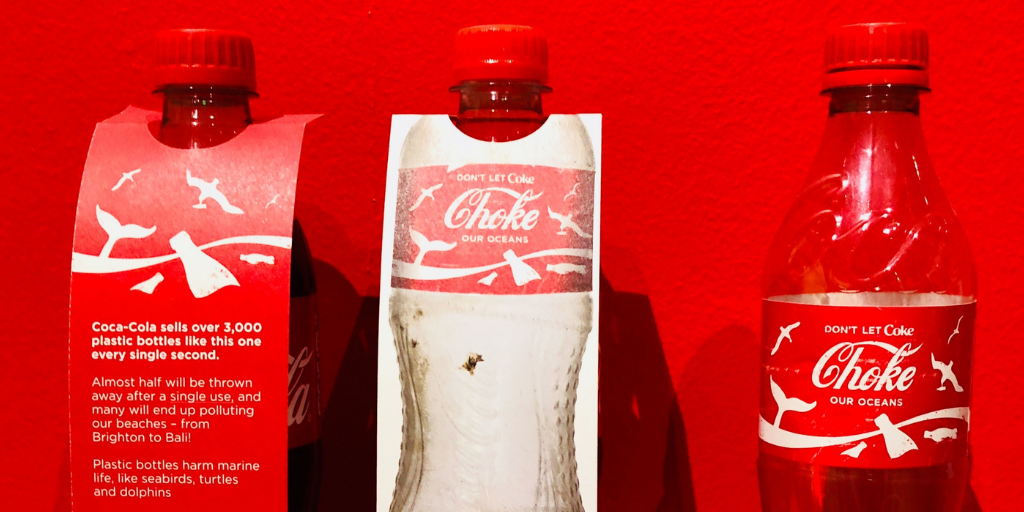Here’s a little story about how an accidental invention and a major innovation caused a worldwide plastic pollution crisis
PET plastic. We're surrounded by it. But what is it, really?
The short answer: Go to any grocery, convenience, big box, or discount retail store and look for a beverage in a plastic bottle. Even easier— look around you right now, and you will see one sitting on a desk or counter, in a gym bag, maybe even in your hand. That’s an example of PET plastic.
Polyethylene Terephthalate doesn’t sound as cute: here’s the longer answer. PET or PETE is the chemical name for polyester, and it is commonly used to refer to packaging. It is used not only for beverage containers but also the plastic packaging for nuts, rice, pasta, beans, salad dressing, squeeze bottles of ketchup, mustard, mayo, relish, mouthwash, shampoo, conditioner, and hand soap... you get the picture. Almost all of the plastics wrapped around your food, beverages, and personal care items.
The PET Plastic Manufacturing Process

Making PET plastic begins with drilling or fracking for crude oil. That oil is brought by tanker trucks to a refinery where they use fractional distillation to separate the crude oil into easier-to-use components. Those components include Ethylene glycol, a molecule that is used for making polyester fibers and antifreeze formulas, and terephthalic acid.
Terephthalic acid is a carboxylic powdery acid with a chemical structure containing a benzene ring. Interesting fact: molecules that contain benzene rings have been associated with cancer. These monomers (a molecule that can be bonded to other identical molecules) attach to each other via polymerization to make a chain and BINGO!We have the basics of PET plastic, a lightweight, durable, water and bacteria-resistant product that solves all of our woes. Right?
But if it’s so durable and resistant to breaking down, where does all that plastic go when we’re done with it?
HOW much PET plastic is out there?
Let’s get a better picture of how much plastic we’re talking about, if you can fathom these numbers. Here are the facts from the Earth Day 2018 End Plastic Pollution campaign:
- In 2016, world plastics production totaled approximately 335 MILLION METRIC TONS, and roughly half of that was slated for single-use.
- Humans buy about 1,000,000 single-use plastic bottles per minute.
- Americans purchase more than 50 BILLION single-use bottles per year.
- 500 BILLION disposable cups are consumed every year. Americans alone throw away 25 billion Styrofoam (a plastic product) coffee cups every year. Most of the Styrofoam disposed of today will still be present in landfills, waterways, and oceans 500 years from now.
- Single-use plastics often do not make it to a landfill or recycling center. Of the 78 million tons of plastic packaging produced annually, 32% ends up in a waterway. Imagine we are pouring one garbage truck of plastic into the ocean EACH MINUTE.
- By 2050 there will be more plastic than fish in the oceans.
- Landfill liners often leak harmful pollutants into the watershed.

We know that we are burying ourselves in plastic trash, yet we continue to reach for the plastic “solution.” Understanding where we’ve been and why the single-use plastic bottle got so popular might help us decide where to go in the future.
Where did PET Plastic come from?
Here’s a quick history behind the journey of our friend, the bottled water.

When will our plastic crisis get better?
With a better understanding of why so much plastic is used for packaging our beverages, food, and more (lightweight, cheap, durable, nonreactive), we can talk about when the life of the plastic bottle ends.
“I recycle.”
You do the right thing. You fill up your curbside recycle containers at home and seek the right places to toss that single-use bottle when you’re out.
The truth is approximately 91% of ALL plastic trash since the beginning of plastic time has not been recycled. Now that China is out of the game, your single-use plastic bottle’s life will probably end in a landfill or waterway. Even if it makes it to a recycling center, most of the bottles will be tossed (up to 70%) before it is down-cycled into pellets for use in other plastic products like stuffing or other filler.
Plastic hasn’t been around long enough for us to understand the true repercussions of what the breakdown of an oil-based, chemically manipulated product like plastic will look like when it starts to break down if it ever breaks down organically. Right now, we have seen what happens when plastic deteriorates into microplastics.
There is plastic in our marine life, they eat it, we eat them. There is plastic in our soil. There is plastic in our drinking water.
Who can make the changes we need to see right now?

You. Start with yourself. Stop buying single-use plastic bottles. Like, never buy another one. If you’re standing in that store and you are looking at a plastic bottle or the aluminum bottle next to it, grab the aluminum one because that is a bottle you can reuse and recycle. Buy yourself a filter if you want. Water bottle refill stations are all over the place, find one, and put it on the map for your fellow humans - with apps like RefillApp.








